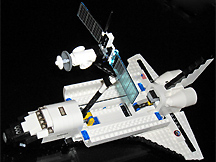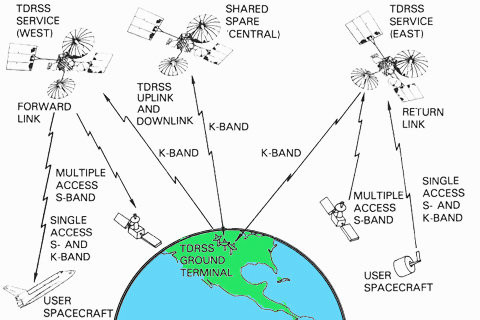Friday 14 March, 2014, 14:28 - Spectrum Management, Much Ado About Nothing
For those who have not yet seen the Oscar winning film, Gravity, please note that although there are no spoilers (in the traditional sense) in the ensuing text, for those who are regular readers of Wireless Waffle, reading what is to follow before seeing the film may leave you with the same level of bemused bewilderment that it did us, and may spoil your enjoyment of the film! So a spoiler that's not a spoiler.The movie begins with a few astronauts on a space-walk (a.k.a EVA) to add some new equipment to the Hubble space telescope. They are communicating with each other using radios built into their space suits and also, at the same time, are able to communicate seamlessly with ground control in Houston.
Following the 'disaster' around which the film's premise is based, the astronauts lose communication with Houston, and, for that matter, any ground based people. According to the film, this has been caused by the loss of the communication satellites that were handling the signals. In addition, their space suit radios seem incapable of communicating with each other over ranges of just a few hundred metres.
Let's first examine the space suit radios themselves. According to a document provided by NASA the range of the communication system between suits is just 80 metres in the worst case (though could be much greater). Given that this system took US$20 million to develop and operates in a 'free space' environment, the poor coverage performance is lamentable. However, it appears that this element of the story might just be feasible. Note that the Russians use a much more off-the-shelf technology for EVA voice communication that has a much greater range!
Could a ground station communicate directly with a space-suit. Based on NASA's paper, and on typical UHF communication systems, no. But with a little ingenuity, for example the use of a high power transmitter and high gain antenna on the ground, it is not beyond the wit of man.
 As for a loss of Earth-space communication being caused by the loss of a communications satellite, there are satellites used to relay data from space to Earth (for example, the TDRSS), however full data communications with a space shuttle could also be accomplished directly from the shuttle to a network of ground stations at S-band frequencies around 2.2 GHz (and voice-only communication at VHF and UHF frequencies). Although in theory, these ground stations could be connected back to Houston via satellite, the chances are that there would be a terrestrial, fibre-based connection that could do the job just as well. So whilst passing over such a ground station, there is no reason why Earth-space communication could not have been re-established. Of course a space vehicle (such as the shuttle) is then needed to relay these signals to any astronauts on EVA.
As for a loss of Earth-space communication being caused by the loss of a communications satellite, there are satellites used to relay data from space to Earth (for example, the TDRSS), however full data communications with a space shuttle could also be accomplished directly from the shuttle to a network of ground stations at S-band frequencies around 2.2 GHz (and voice-only communication at VHF and UHF frequencies). Although in theory, these ground stations could be connected back to Houston via satellite, the chances are that there would be a terrestrial, fibre-based connection that could do the job just as well. So whilst passing over such a ground station, there is no reason why Earth-space communication could not have been re-established. Of course a space vehicle (such as the shuttle) is then needed to relay these signals to any astronauts on EVA.
There is then a moment when one of the astronauts finally receives a signal from the ground but it appears to be from a Chinese man whose dogs and baby can be heard to be barking and crying (respectively) over the air. Whilst tuning into these transmissions, the astronaut in question says 'you're coming in on an AM frequency'. What is an AM frequency when it's at home? AM is a modulation scheme and not a frequency. And why would someone sitting at home in China be using any kind of frequency that is shared with Earth-space communications? And the communication seems to be full duplex as the astronaut can communicate with the man on the ground concurrently with listening to his transmissions. None of this makes much sense.
 And lastly, communication with the ground is finally re-established when a landing module descends into the atmosphere. The range of the types of frequencies used for Earth-space communications at atmospheric altitudes is limited by the curvature of the earth, (e.g. at 30,000 feet, the range of communications is roughly 300 km). This would mean that those on the ground would have needed to be aware of the location where the landing module was coming down (odd that they could do this if they had had no communication with the landing module until that point) and thus be in the neighbourhood for communications to be possible.
And lastly, communication with the ground is finally re-established when a landing module descends into the atmosphere. The range of the types of frequencies used for Earth-space communications at atmospheric altitudes is limited by the curvature of the earth, (e.g. at 30,000 feet, the range of communications is roughly 300 km). This would mean that those on the ground would have needed to be aware of the location where the landing module was coming down (odd that they could do this if they had had no communication with the landing module until that point) and thus be in the neighbourhood for communications to be possible.Whilst the film may have excelled for its special effects, the way in which the radio communications were portrayed will be a real 'spoiler' for anyone who knows anything about the radio technologies or radio propagation. Still, science-fiction, by its definition, doesn't need to be scientifically accurate!
